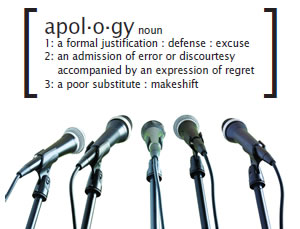by Rev. Travis J. Scholl

About this time a year ago, I was voraciously reading tennis star Andre Agassi’s autobiography Open. I read it partly as a fan, but I also read it because in his publicity interviews for the book he often referred to it as his “atonement.” Consider what Agassi told CNN: “Every day from that second chance I had [in tennis] I’ve been atoning for this—it has been a heavy weight on me. This book is an atonement of sorts.”
I was intrigued by his feeling that this act of writing was an act of redemption. Note the heavy religious overtones of his language. Granted, the language sounds more like penance than the language of free forgiveness that Lutherans speak of. Nevertheless, it is language steeped in the tea leaves of redemption.
This can seem to cut against the grain of a culture that seems to have forgotten about sin. But perhaps it is part and parcel of a culture that no longer sees sin and redemption as the exclusive domain of religion or spirituality. We live in a coming-clean, tell-all world where confession is literally a public act, an event, even a spectacle, a part of the spin campaign. Just go to YouTube and search for “apology” and “Tiger Woods.” Or “Mark McGwire.” Or “David Letterman.”
The cultural logic of the phenomena works like this: A beloved celebrity does something wrong (although the moral standard by which the act is judged isn’t always clear). He or she loses credibility, reputation and a few endorsement deals. When the person reaches a publicrelations point of no return, he or she makes a confession . . . on national TV . . . before an audience of millions. And eventually, we all move on to something new.
Now I’m not questioning whether or not their confessions are genuine. People make that judgment on their own. I’m only describing the act as an event, which begs the question: Why do we watch? At its simplest, it is because we’re the ones who get to grant forgiveness. We’re the confessors, and they’re the ones making confession. It’s still the court of public opinion, after all.
All this points to the fact that, more often than not, we make sense of culture—and culture makes sense of us—through narrative. More precisely, we view events and experience, especially when they are notorious, through the lenses of certain archetypal narratives to make sense of what is happening. We can call this one the narrative arc of redemption.
Or we can call it “the VH-1 effect.” The cable network VH-1 made this narrative arc implicitly famous with the show “Behind the Music.” The show chronicled the life and times of innumerable pop stars through a familiar—and paro-died—formula of rise to fame, downfall from grace and redemption to newfound glory.
Sound familiar? As Christians, we often live in creative tension with this cultural story. This is mainly because in a previous era of Christendom the cultural narrative was fueled by Judeo-Christian narratives of redemption: David confronted by the prophet Nathan, the prodigal returning home, Saul on the road to Damascus. In a sense, Christianity invented the narrative, and popular culture has been borrowing it ever since.
The trouble with this borrowing is that it becomes a story without a cross. To provide real atonement, the Christian story of redemption requires death: the temple scapegoat banished to die in the desert, the Messiah hanging from a tree of pain, the old self drowned in baptismal waters.
And death is too far to go, not only for a culture obsessed with scandal, but for all souls who are honest with themselves. We live in a culture that has forgotten about sin because we are part of a humanity that fears death. And so we remake the cosmic story of redemption into a domestic docudrama of tabloid proportions.
The story is all too human. Even the narrative arc itself is caught in a web of brokenness, betrayal and the loss of innocence. The inescapable fact remains: Even when our culture lives as if it is without sin, the feelings of guilt and shame still boil over. This is the part of the story Paul knew all too well: “They show that the work of the Law is written on their hearts, while their conscience also bears witness” (Rom. 2:15). That which we call sin by any other name would still smell as foul. And in the end, a broken heart is a broken heart.
This is exactly why we need the cross to break the cycle of the story. But the death of the cross is a death unlike any other. It is the death of God in Christ Jesus that puts to death everything that separates us from God and from each other.
It is perhaps ironic that within a cultural narrative that has become alienated from its religious sources, the narrative of the cross overcomes every human alienation. The narrative of the cross can even redeem the narratives by which we make sense of the world. We catch glimpses of this at work in the narrative concept called the “Christ-figure.” The parallels are often imperfect, but think of a character like John Coffey (look at his initials) in the movie “The Green Mile” or the lion Aslan in C. S. Lewis’ “The Chronicles of Narnia.” These Christ-figures, whether intentional or not, are a faint but glimmering reflection of the Christ who has come to set us free.
But why look at the reflection when you can see Him face to face? At the end of the story of faith—the story we have just begun to recount in the season of Lent—is a tomb. But the tomb is empty. And the Christ who is risen from there still lives, even today.
But that’s another story for another Sunday.
—
> The Lutheran Service Book has a service of private confession and absolution, meant just for you and your pastor!
> Did you know? luther wrote, “confession embraces two parts: the one is, that we confess our sins; the other, that we receive absolution.”
About the Author: Rev. Travis J. Scholl is managing editor of theological publications at Concordia Seminary, St. Louis.
March 2011






